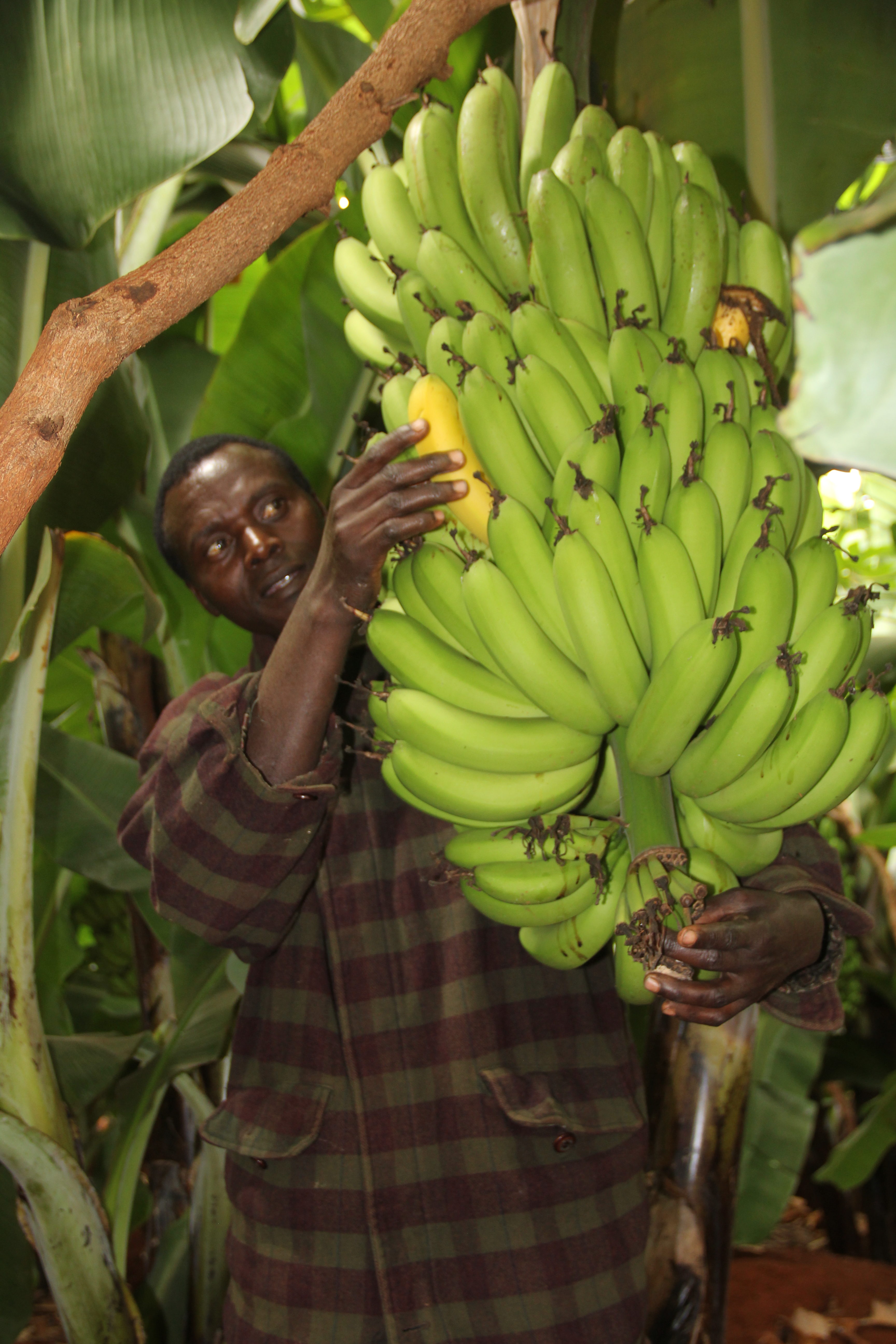By Clifford Akumu
Deadly diseases such as Panama, Banana Xanthomonas Wilt (BXW) and pest infestation are some of the reasons for low yields. Poor farming practices and use of infected planting materials also contribute to the decline in banana production.
Lured by a ready market and better returns, Michael Kinyua, 49, shifted to tissue culture bananas which grow faster and give increased yields compared to the traditional species.
Like other farmers in Kagondo, Mwea East-Kirinyaga County, the father of three is smiling all the way to the bank as the crop has become his main source of income in this semi-arid region.
Mr. Kinyua pockets about 30, 000 – 80,000 ksh every month from one and a half acre piece of land.
“I have been able to buy two dairy cattle and around 200 rainbow rooster chickens using proceeds from my farm.” Said Kinyua.
Kinyua has 850 tissue culture banana stems of Grand-nine variety which does well in Mwea.
“My plants are now mature and produce more than three times without a halt” noted Kinyua.
Kinyua was introduced to banana macro-propagation technology in 2016 through training conducted by village based advisors working with Farmers Input Promotion(FIPS-Africa) developing innovative approaches to enable smallholder farmers become food secure.
In early 2014 Kinyua was planting the traditional banana variety but reported dwindling yields due to infestation by diseases. But his yield increased in 2016 when he planted 216 stems of Grand-nine variety.
“I bought the plantlets at Sh100 from FIPS-Africa. A move that has changed my life” said Kinyua.
The initiative is an ambitious step by the organisation to equip smallholder farmers with tools to fight deadly banana diseases by producing clean planting materials and become food secure.
Mrs. Hellen Nyaga, a network coordinator with FIPS-Africa says the use of clean planting materials has revolutionized banana growing in the county.
The secrets of bountiful harvest, she adds, depends on planting disease free plantlets and following good crop husbandry practices, including proper mulching.

“Production of disease-free banana planting materials has improved the livelihood of smallholder banana farmers in the County .” said the network coordinator.
Kenya produces over one million tonnes of bananas annually, but loses over 40 per cent to pests, poor harvesting techniques or lack of markets.
Disease free banana plantlets are produced in a specially made chamber similar to a greenhouse.
Banana propagation starts with clean suckers that are ready for transport.
“In macro-propagation we advise farmers to uproot the sucker that is next to the mother plant called swor.” Said the NC
“Immerse the clean suckers in the boiled water for thirty seconds. You then peel off the back one by one-a process called ‘killing of the male parts. And then peel from the roots” noted Nyaga.
As one does this, a chamber of one and a half feet deep filled with ballast at once inch and sawdust should be ready.
“The chamber is always one metre width but the length may vary. Cover the chamber using nylon or colourless polythene. Then the sawdust which has been boiled for two hours is then put in the chamber.” explained Mrs. Nyaga.
After two months, the plantlets are ready for transplanting to the farm.
Kinyua also produces banana plantlets and sell to other farmers at Sh100 per stem.
“I make about Sh5000 from the sale of the plantlets.” said Kinyua.
Bulk production of the plant attract good money, hence the need to encourage other smallholder farmers to increase area under production.
“I am encouraging those with idle land to grow improved banana varieties as a source of income and food security” said Kinyua
According to Kinyua the crop matures in nine months, which guarantees farmers coordinated harvesting and marketing.
Market for his bananas has never been a problem, since he sells directly from his farm a trend that has enabled him evade the middlemen menace.
“Selling at the farm is the best way. I only need to weigh and count the money. A kilogram of the produce goes for 14-16 Ksh in the market depending on the demand and availability.” said Kinyua.
Growing banana involves digging a hole of 4m by 2.5m and apply one wheelbarrow of manure. One can opt to mix with Mavuno fertilizer or DAP.
After planting the propagated, it takes one year then it starts yielding.
Mrs. Nyaga says that the crop needs a lot of water which is scarce in greater parts of Mwea.
And to avert the acute water shortage, she advises farmers to trap run-off water as well as dig water reservoirs for their plants.
“The greatest problem facing banana farmers is water. We teach every farmer on water harvesting techniques.” Advised Nyaga.
Superior water pumping machine will increase his production, he says.
“My target is to reach 3,000 stems of Grand-nine variety in two years from now.” Said Kinyua.













